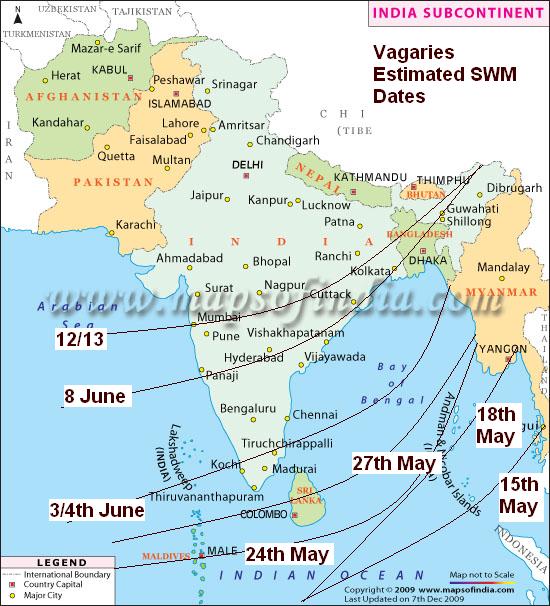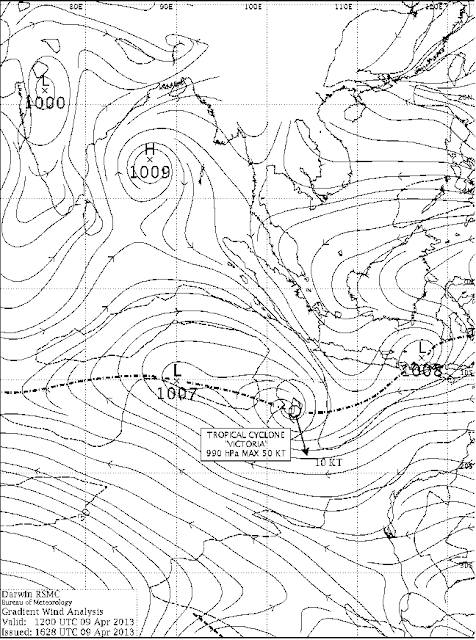Monsoon Watch -3 2013 (Additional)...April 30th.
The arrival date is calculated seeing todays position. Further from today, we presume the normal rate of progress of the Monsoon (In cricket parlance:projected score at the current run rate).
This initial estimated dates are subject to some changes, and will be finalised around mid-May, when the puzzle pieces look well arranged.
As of today, there seems to be a slight delay in both, Arabian Sea and Bay Branches of the Monsoon. There continues to be a doubt on the timely arrival of the Monsoon in the Bay branch.
Bay branch needs to wait a few days for the embedded Lows to fizzle out, and to get going.
Arabian Sea Branch: Though there is some improvement in most of the parameters, there is still much to be achieved, and most parameters are still lagging behind time, and are -ve.
The Arabian Sea branch, may not be affected by the temporary "dis-organisation " in the equatorial winds at the equator. ( Provided they regroup fast).
(Dates in brackets are the normal dates of arrival).
On these calculations, Vagaries would maintain the Monsoon to reach Maldives around the 24th of May 2013(20th May), Sri Lanka around 27th/28th of May (25th May).
Kerala by the 3/4th June (1st June).
Hence, maintaining and presuming the normal rate of progress, Goa should get Monsoon rains by around 8th June (5th June).
Mumbai by 12/13th June (9th June). Regular Pre Monsoon thundershowers could start from around 6/7th June 2013.
Bay Branch: SWM should hit South Andaman Sea around 15th.May (12th May), and rest Andaman Islands by 18th-20th May 2013.
Generally moves up (normally) the Bay at a sustained speed, and Kolkata should see Monsoon arrival by the 9th of June, along with the NE states.
We stop at this initial progress, and work out further region wise progress at a later date (as is the usual practice in Vagaries' MWs).
These Dates are worked out and estimated as per my personal calculations and may not be used for commercial purposes.The dates are not binding on anyone and no responsibility is taken if used for any purposes.
The arrival date is calculated seeing todays position. Further from today, we presume the normal rate of progress of the Monsoon (In cricket parlance:projected score at the current run rate).
This initial estimated dates are subject to some changes, and will be finalised around mid-May, when the puzzle pieces look well arranged.
As of today, there seems to be a slight delay in both, Arabian Sea and Bay Branches of the Monsoon. There continues to be a doubt on the timely arrival of the Monsoon in the Bay branch.
Bay branch needs to wait a few days for the embedded Lows to fizzle out, and to get going.
Arabian Sea Branch: Though there is some improvement in most of the parameters, there is still much to be achieved, and most parameters are still lagging behind time, and are -ve.
The Arabian Sea branch, may not be affected by the temporary "dis-organisation " in the equatorial winds at the equator. ( Provided they regroup fast).
(Dates in brackets are the normal dates of arrival).
On these calculations, Vagaries would maintain the Monsoon to reach Maldives around the 24th of May 2013(20th May), Sri Lanka around 27th/28th of May (25th May).
Kerala by the 3/4th June (1st June).
Hence, maintaining and presuming the normal rate of progress, Goa should get Monsoon rains by around 8th June (5th June).
Mumbai by 12/13th June (9th June). Regular Pre Monsoon thundershowers could start from around 6/7th June 2013.
Bay Branch: SWM should hit South Andaman Sea around 15th.May (12th May), and rest Andaman Islands by 18th-20th May 2013.
Generally moves up (normally) the Bay at a sustained speed, and Kolkata should see Monsoon arrival by the 9th of June, along with the NE states.
We stop at this initial progress, and work out further region wise progress at a later date (as is the usual practice in Vagaries' MWs).
These Dates are worked out and estimated as per my personal calculations and may not be used for commercial purposes.The dates are not binding on anyone and no responsibility is taken if used for any purposes.









































